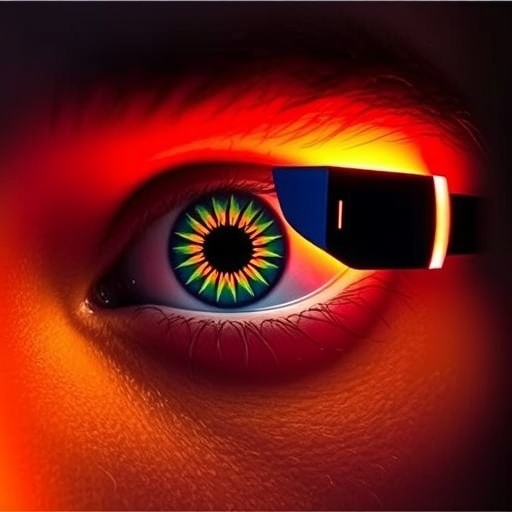In a groundbreaking advancement poised to revolutionize ocular health monitoring, a research team led by Professor Changlong Jiang at the Institute of Solid State Physics, Hefei Institutes of Physical Science of the Chinese Academy of Sciences, has engineered an innovative wearable device capable of non-invasive, real-time detection of lysozyme levels in human tears. Utilizing a novel multi-emission metal-organic framework hydrogel (Eu-Dy MOF gel), this eye patch sensor integrates seamlessly with smartphone technology, heralding a new era in personalized eye health diagnostics.
Lysozyme is an essential protein functioning as a natural antimicrobial agent, crucial for maintaining ocular surface immunity and preventing infections. Abnormal fluctuations in lysozyme concentrations can be indicative of various ocular pathologies including dry eye syndrome, infections, and inflammatory diseases. Current lysozyme detection methods are either invasive, requiring tear fluid extraction via microcapillary tubes, or necessitate elaborate laboratory equipment, limiting accessibility and real-time feasibility for routine monitoring.
Addressing these limitations, the Jiang laboratory has developed a fluorescent eye patch sensor that exploits the unique photophysical properties of Eu³⁺ and Dy³⁺ ions embedded within the metal-organic framework hydrogel matrix. The Eu-Dy MOF gel serves as an ultra-sensitive optical probe, capitalizing on the “antenna effect” whereby organic ligands absorb excitation energy and efficiently transfer it to lanthanide ions, prompting bright and stable luminescence. This energy transfer mechanism ensures high quantum yields and enhanced detection sensitivity, pivotal for accurate biomarker quantification.
This technology operates by adhering the Eu-Dy MOF gel-based eye patch beneath the lower eyelid, where tear fluid naturally accumulates. Upon exposure to ultraviolet (UV) light, the sensor emits characteristic fluorescence whose intensity inversely correlates with lysozyme concentration due to specific quenching interactions. When lysozyme binds to the MOF gel, mechanisms including static quenching and localized electron transfer reduce the emission intensity, manifesting as measurable fluorescence attenuation in the blue spectral region.
What distinguishes this sensor is its compatibility with ubiquitous smartphone technology. Users can illuminate the patch using a portable UV source and capture the fluorescence emission with a smartphone camera. Advanced color recognition algorithms embedded in a dedicated application translate these optical signals into quantitative lysozyme concentration readings, enabling immediate feedback without the need for laboratory assays or specialized instruments.
The system exhibits remarkable sensitivity, boasting a detection limit as low as 1.5 nanomolar for lysozyme. This sensitivity surpasses that of many conventional enzymatic and immunoassay techniques, positioning it as a premier candidate for continuous eye health surveillance. Moreover, the non-invasive wearable format provides unparalleled comfort and convenience, encouraging frequent monitoring and early detection of pathological changes.
Beyond clinical applications, this sensor platform underscores the expanding utility of metal-organic frameworks (MOFs) in biomedical diagnostics. The tunable porosity, functionalizability, and luminescent properties of MOFs make them exceptional candidates for designing responsive biosensors. Incorporating rare-earth ions further enhances optical performance, stability, and selectivity, allowing for precise detection even in complex biofluids like tears.
The interdisciplinary collaboration underlying this innovation bridges material science, analytical chemistry, optics, and digital health, exemplifying how convergence of diverse fields can forge practical solutions to pressing healthcare challenges. By enabling early disease warning and personalized medical guidance, such smart biosensors may significantly reduce the burden of ocular diseases globally, especially in populations lacking access to specialized healthcare.
Professor Jiang notes, “Our wearable Eu-Dy MOF fluorescent sensor represents a significant step towards realizing personalized, real-time health monitoring through accessible, non-invasive means. By leveraging advanced materials and smartphone technology, we envision widespread adoption of this platform not only for ocular diagnostics but potentially for detecting other biomarkers across varied bodily fluids.”
Integration with smartphones bodes well for mass-market penetration, considering the global proliferation of mobile devices and the increasing trend toward health-conscious consumer technologies. This synergy transforms ordinary smartphones into potent diagnostic tools, democratizing health insights and empowering users with actionable information.
The potential for expansion of this technology is vast. Modifying the metal-organic framework chemistry to target additional biomarkers could facilitate multiplexed sensing platforms capable of comprehensively assessing ocular surface conditions and systemic diseases manifesting in tear compositions. Future iterations may include real-time data transmission to healthcare providers, fostering telemedicine and remote patient monitoring ecosystems.
Published in the prestigious journal Analytical Chemistry in June 2025, these findings not only illuminate the path for next-generation biosensors but also contribute fundamentally to the understanding of fluorescence quenching mechanisms in MOF-based systems. The elucidation of interactions between lysozyme and Eu-Dy MOF gels enriches the field of bioresponsive materials and optical biosensing.
In conclusion, the advent of the Eu-Dy MOF gel eye patch sensor embodies a paradigm shift in non-invasive biomarker monitoring, marrying sophisticated material design with everyday technology. This innovation holds promise to transform how ocular diseases are detected and managed, fostering healthier eyes through smarter, easier, and real-time diagnostics accessible to all.
Subject of Research: Non-invasive, wearable fluorescent sensor technology for real-time monitoring of lysozyme in tears using Eu-Dy metal-organic framework hydrogel integrated with smartphone analysis.
Article Title: Rare Earth Ion-Induced Functionalized Fluorescent MOF Hydrogel Patches for Monitoring Lysozyme in Tears
News Publication Date: 26-Jun-2025
Image Credits: PANG Lei
Keywords
Physical sciences




